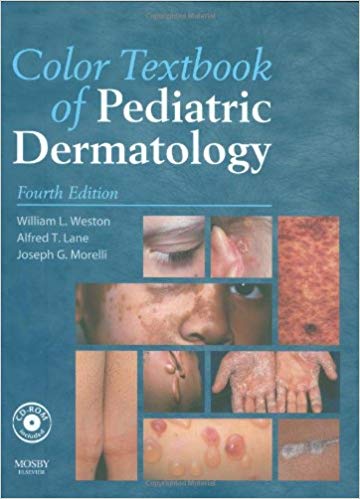Color Textbook of Pediatric Dermatology (2007) would ordinarily lie on the margins of the spectrum of books that I’d consider review-worthy: it’s approximately 400 pages long, has multiple authors and is, well, a textbook. Longer, multiple-author textbooks tend to fall apart conceptually at about 400 pages in length. This book, however, holds things together very nicely throughout.

What makes this book work so well is the authors’ deep understanding of the natural histories of pediatric dermatological diseases, as well as their excellence in the formation and discussion of differential diagnoses (which is really just a corollary to understanding the natural history of diseases!). Also, the readings are easy to follow and absorb because the pages aren’t particularly large and there are ample high-quality photographs to go along with the text..
Take Staphylococcal Scalded Skin Syndrome as an example. The condition is covered in approximately two medium-sized pages, which is very reasonable for a condition this important. The discussion is broken down into subheadings of Clinical Features, Differential Diagnosis, Pathogenesis, Treatment, Patient Education and Follow-up Visits (Who can do better than that?). Here are a few highlights of the discussion:
Staphylococcal Scalded Skin Syndrome (SSSS) [is] … a spectrum of clinical presentations … ranging from … bullous impetigo … to generalized involvement….
Toxic epidermal necrolysis, which is often drug induced, may be differentiated from SSSS by skin biopsy and by the preceding history of urticarial or target lesion occurring 2-3 days before the appearance of bullae.
Color Textbook of Pediatric Dermatology (2007), pages 70-71
The book then, of course, goes on to show several excellent pictures of babies and children with SSSS.
Good luck with trying to buy a hard copy of this book, which is apparently out of print. As of this writing, a new one costs approximately $1,900! You can get a used one for about a tenth of that price, while the digital versions costs around $125. (The hard copy come with a CD-ROM which I suspect may be pretty much unreadable with most of today’s technology).
Is it worth it? Yes! Anyone who provides medical care to children in primary care settings should read this book at least once. It will give you a very solid foundation for understanding how to care for infants and children with dermatological problems. (Dermatologists, on the other hand, might be better served by a heftier reference book).
Participation question
What is your favorite pediatric dermatology learning resource and why?


Leave a Reply